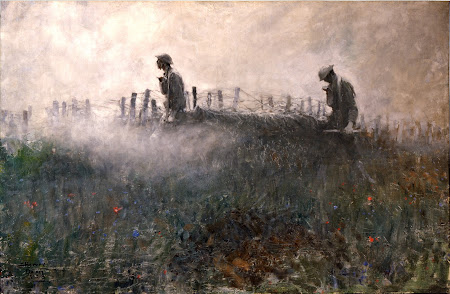Non Western Blog: Japan
Choshi in Shimosa Province by Hokusai
Created in 1833, this art piece is a print made by the famous Japanese artist Hokusai who also made the famous painting The Great Wave. He uses a technique known as woodblock and ink painting where a design is carved into a wood block and then ink is applied before pressing into paper or fabric. Hokusai is one of the first Japanese artists to appear internationally with this technique.
I love the Japanese style of art because of the attention to detail, but also because there is so much character to each of the pieces. In this piece in particular, I love how it seems like a scene of turmoil, yet it is still so peaceful to look at. The lines play a key role in making the piece come together with the calm straight lines of the waves turning into the chaotic sea spray.
Me, Somewhere Else by Chiharu Shiota
First shown in London in 2018, Chiharu Shiota is a Japanese artist based out of Berlin who uses cloth and yarn for art installations. This piece is a representation of how the mind is connected to the body. Even the color of the yarn is carefully chosen as it is important in Japanese color, but is also the same color as blood, once again connecting the mind to the body.
This art piece really speaks to me about mental health and the way that people perceive it. The expansion of red intertwined symbolizes the interconnected thoughts that a person had within their brain and how there is so much going inside their physical self. I find it interesting that Shiota chooses feet to represent the physical aspect of an individual making me feel like she is trying to convey a feeling of being ground in one's thoughts and perspectives.
Ninagawa is a Japanese photographer and director who specializes in very saturated and bright colors. Because of the bright colors and the subject of her portraits, she is seen as a symbol for Japanese youth culture.
I really like the colors of this photo in particular. Typically, Ninagawa uses more pinks and purples in her photos, but the use red and greens in this piece make it stand out against all the others. Fish in Japanese culture represent survival and so I find it interesting how they are the subject of many of Ninagawa's photos.
Winter and Autumn Landscapes by Sesshu Toyo (1420-1506)
Created in Japan, this piece was created in the late 15th, early 16th century. Sesshu trained as a Samurai but later became a Zen priest and painter. He also spent three years in China observing artists and visiting temples where he learned more about realistic styles of art. The technique that Sesshu uses is many of his art his water and ink painting to create different seasonal landscapes, birds, and portraits.
Sesshu paintings are very technical and even though there is no color, it is easy to see the difference between the the winter portion of the painting versus the autumn portion. I really appreciate how calming the painting is and how it offers a sense of peace when viewing it. The building in the mountains is very serene and I love to find new details every time I see it, like the tree that are peaking out of the side.
Source:
Kalled, Jes. “35 Most Famous Japanese Artists You Should Know.” Japan Objects, 8 Apr. 2023, japanobjects.com/features/famous-japanese-artists.
“A Timeline of Japanese Artist Katsushika Hokusai.” The British Museum, www.britishmuseum.org/exhibitions/hokusai-great-picture-book-everything/timeline-japanese-artist-katsushika-hokusai. Accessed 27 Apr. 2023.
Chiharu Shiota: Me Somewhere Else at Blain|southern, www.galleriesnow.net/shows/chiharu-shiota-me-somewhere-else/. Accessed 27 Apr. 2023.
-トーハク-, 東京国立博物館. “National Treasure Gallery: Autumn and Winter Landscapes.” TOKYO NATIONAL MUSEUM, www.tnm.jp/modules/r_exhibition/index.php?controller=item&id=4271&lang=en. Accessed 28 Apr. 2023.
“Liquid Dreams.” 蜷川実花|Mika Ninagawa, mikaninagawa.com/publications/liquid-dreams/. Accessed 28 Apr. 2023.






Comments
Post a Comment